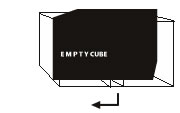IVAN ŠULETIĆ
OCTOBER, 17, 2013

CONTACTS
suleticivan@gmail.com
EXHIBITION INFORMATION
TRIUMPHAL ARCH
Wood, India ink on paper
Model and monument
Ivan Šuletić (Belgrade, 1982) brings to this edition of EMPTY CUBE a project that takes the cube's ephemeral structure and turns it into a fragmented construction that conjures up the feel of a large-scale model, or even maquette – but not a replica – of something that might be a study for a monumental arch. We associate the arch with the biunivocal condition of a passage between impermanence and perenniality. By being here applied to a triumphal arch, this metaphor becomes closely connected to a ritual whereby man is transmuted into his heroic alter ego, surpassing his earthly incarnation by means of that portal or filter that both separates and reconnects humanity and eternity and projecting himself as an apparatus of a fantastic and wondrous universe, as seen through Baroque-era eyes.
The title of this ephemeral piece, 'Triumphal Arch', consists essentially of an ironic play on the historic references contained in the triumphal arch, both as a political symbol and as an architectural structure. This reference to a specific monumental typology also evokes a celebration of war, a victory that will be forever recorded as the memory of a battle, displaying its heroes at the centre of an urban landscape. The triumphal arch is a structure that has long run through mankind's history, and which emerged during the Romanisation of the Western world as an urban epicentre that defines and evokes the representation of assertive power, reifying it for future generations.
But Šuletić's piece holds many other possible readings. His body of work, recent though it may be, is closely related to architecture and public spaces, even if he is far from being a part of a lineage of artists who produce what is generally known as 'Public Art'. His outlook on the world expresses a political reflection on forms drawn from Western culture that transcends the filiation to its original location (and its transitional systems): the former Republic of Yugoslavia. The artist sets his sights on universally symbolic structures, such as the triumphal arch, to develop his musings on architecture as a permanent, celebratory construct, and also on the construction and validation processes of common, shared urban spaces where individual memory becomes interwoven with the systematisation of collective memory.
Between these premises, the 'Triumphal Arch' project develops itself in EMPTY CUBE by recontextualising the passage as a drifting motion over the drawings displayed on the plinths that can be found inside and around it. In other words: the work requisitions the arch's model as an act of resistance against the monument as the prevalence of becoming, as the legacy and avatar of the unifying memory's continuity. This stance is visible in the (apparently abstract) drawings, which mimetically relate to the architecture's typified design, like preparatory drawings that convey the obsolescence of finishing a project for a triumphal arch. They are like flat planes cut according to a regular pattern that avoids ornamental value, as well as evoking any identifiable symbols and references.
Thus the concept of monumentality finds itself reconverted in terms of the rarefaction of the very signs that promoted it and turned it into a symbolic place for the memory and the autocracy behind its establishment. All this regardless of its provenance or historic massification, which began long before our vocabulary had become a kind of Esperanto in thrall to the universal translation of the globalisation concept.
João Silvério






